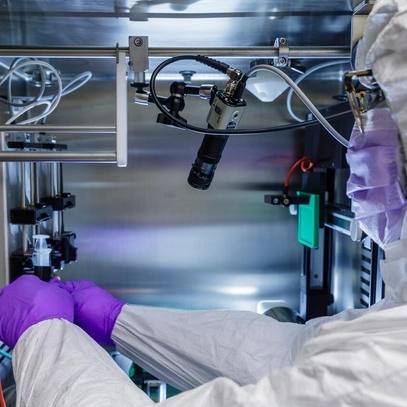-
Biotherapeutics
Science Saturday: Turning back the clock on aging
Researchers at Mayo Clinic are probing ways to activate the body’s regenerative potential to slow the clock on chronic conditions that set in as we age. From cancer to diabetes to Alzheimer’s disease, another birthday adds to a person’s risk of developing chronic disease. September is Healthy Aging Month, a time to focus on the positive aspects of aging.Mayo Clinic Center for Regenerative Medicine, which is leading a therapeutic paradigm shift from treating disease to restoring health, is working collaboratively with researchers in the Robert and Arlene Kogod Center on Aging. Together they are seeking to solve the puzzle of why the body’s healing abilities wane as a person grows older.

“We’re quite interested in what it is it about aging that compromises the ability of our bodies to rejuvenate. We want to know what it is about the process of aging that leads to the molecular and cellular damage associated with different diseases and geriatric syndromes,” says Nathan LeBrasseur, Ph.D., a researcher within the Kogod Center and lead investigator in regenerative medicine of aging.
The aim of Mayo’s research is not to increase life span, but to increase health span — delaying the onset of disease and disability as long as possible in order to live a healthier, higher quality of life in the years a person does have.
Senescent cells and regeneration
Cell senescence, a state of growth arrest, plays a key role in aging. Damage to cells, and particularly their DNA, due to natural aging processes or environmental factors such as cigarette smoke, causes cells to become senescent. Senescent cells no longer divide and differentiate. They then lose their ability to repair tissue. Also called zombie cells, senescent cells secrete harmful proteins and chemicals, creating sort of a “toxic soil” locally, if not globally, that disrupts the function of stem cells. That can sap the body’s ability to heal from injury.
Though senescent cells are relatively few, they accumulate with advancing age. Ultimately, they contribute to disease and failing health. Dr. LeBrasseur compares it to one bad apple spoiling a whole bushel.
“What’s interesting about a senescent cell, is it is a robust secretory factory, if you will, pumping out cytokines, chemokines and other factors into the local environment that creates all kinds of havoc. It compromises the health and function of neighboring cells and the surrounding tissue,” says Dr. LeBrasseur. “In the field of aging, we often talk about inflammation as a primary cause of disease. Factors secreted by senescent cells clearly contribute to a state of chronic sterile inflammation, or a smoldering fire, which can burst into a conflagration and drive disease.”
Mayo Clinic research has found that removing senescent cells could halt the aging process and restore tissue regeneration in an organism. Through both genetic and pharmacological strategies, researchers have shown senescent cell clearance improves age-related diseases of the lung, bones, vasculature, brain, kidney, liver and other organs.
“Our research shows that targeting senescent cells can markedly improve the health and function of an organism and in part it does enhance tissue rejuvenation. So, if you get rid of senescent cells, you may be able to improve healing and tissue regeneration in older adults following injury,” says Dr. LeBrasseur.
Dr. LeBrasseur’s research team is interested in discovering the answer to two key questions in the context of regenerative medicine: Could removing toxic senescent cells improve the body’s own regenerative potential in later life? Can senescent cell clearance be a kind of pre-treatment for emerging regenerative therapies, such as stem cells or stem cell-derived products?
Exercise is regenerative medicine
In the absence of an approved FDA therapy to eliminate senescent cells, exercise and healthy diets could act as a natural therapy.
“We’ve published one study that in at least the context of obesity, finds exercise can prevent senescent cell accumulation and, to some extent, clear senescent cells from the body,” says Dr. LeBrasseur. “Exercise has profound effects on our cells and their capacity to repair different aspects of cell damage that are linked to aging and age-related diseases. For example, exercise improves the cells’ ability to repair DNA, manage oxidative stress, and turn on the garbage disposal and get rid of old damaged proteins.”
It may sound rote, but Dr. LeBrasseur says the guidelines recommended to maintain overall good health also apply to aging: 30-minutes of moderate-to-vigorous exercise most days of the week could benefit the body’s ability to maintain its regenerative potential, and therefore could be like turning the clock back on aging. In contrast, lack of exercise and unhealthy eating are linked to age-related cell damage and chronic disease.
“Exercise is regenerative medicine,” Dr. LeBrasseur says.
Based on the findings from work in animal models, human studies are now underway. This research could confirm the role of senescent cells in human aging and whether removal of these cells by drugs, diet, exercise, or combinations thereof could pause or reverse the loss of regenerative abilities linked to aging.
###
Related article:
Discovery's Edge: "Toxic Cellular Ooze Linked to Biological Age, Disease and Disability"
Additional research by Dr. LeBrasseur:
The senescence-associated secretome as an indicator of age and medical risk







